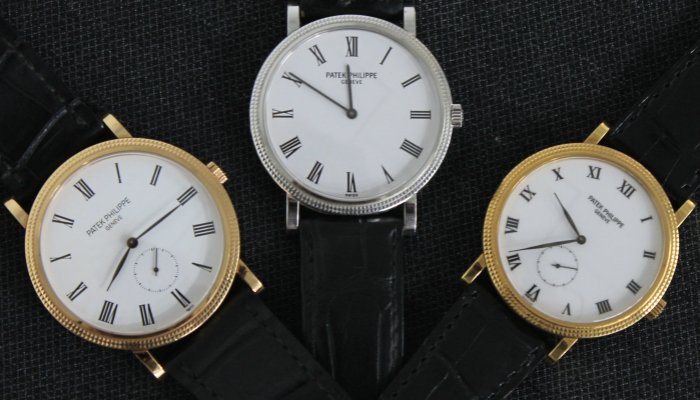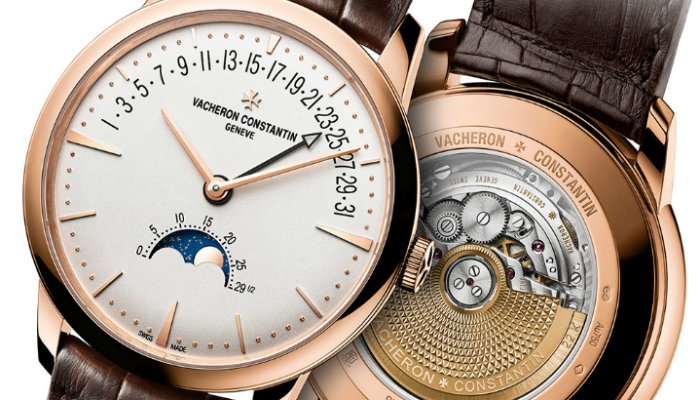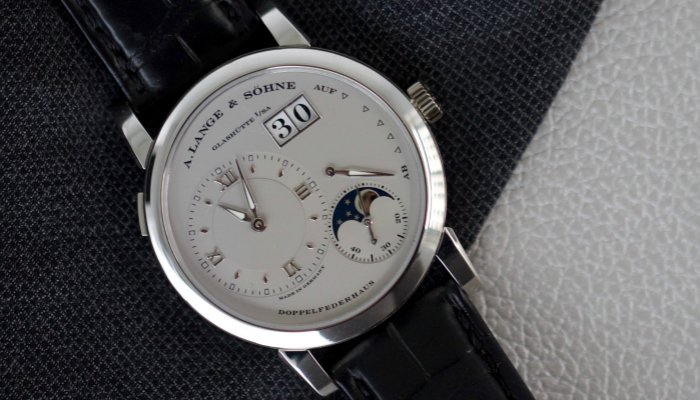3 Flagship Models from Ultra-Luxury Watchmakers
At the top of the haute horology pyramid sits three of the best luxury watch companies in the world: Patek Philippe, Vacheron Constantin and A. Lange & Söhne. Although these masters have given us countless unforgettable timepieces over their long histories, each manufacturer has a flagship collection that enjoys the most respect and greatest popularity. Here we take a look at the Patek Philippe Calatrava, the Vacheron Constantin Patrimony, and the A. Lange & Söhne Lange 1 to see what makes these signature models so exceptional.
Patek Philippe Calatrava

Originally founded by Antoine Norbert de Patek and Jean-Adrien Philippe in the mid-1800s, Patek Philippe was purchased by brothers Jean and Charles Henri Stern in 1932. That same year, the Calatrava made its debut.
The simplicity of the Calatrava was markedly different from preceding Patek Philippe designs which were famously complicated timepieces with split-seconds chronographs, minute repeaters, and perpetual calendars. The simplicity of the time-only Calatrava was a stark contrast.
Based on the Bauhaus design principle, in which form follows function, the first Calatrava, Ref. 96, featured a slim round 31mm case, clean dial, two center hands for the hour and minutes, and the small seconds subdial. The understated elegance of the Calatrava dress watch was immediately well received by the luxury watch clientele and remains Patek Philippe’s signature model today.
The Calatrava is available in a wide range of models available for both men and women. One of the most popular modern Calatrava models is the Ref. 5196, first introduced at Baselworld 2004. Clearly inspired by the inaugural Calatrava, the manually-wound Ref. 5196 sports a refined 37mm case, center hour and minute hands, and a seconds subdial. The Calatrava ref. 5196 is available in white, pink, and yellow gold and platinum.
Vacheron Constantin Patrimony

Vacheron Constantin has the distinction of being one of the oldest Swiss watch brands still in existence today and has cultivated a culture of watchmaking excellence. Founded in 1755 by master watchmaker Jean-Marc Vacheron, the company became known as Vacheron Constantin in 1819 when Jacques Barthélémi Vacheron—grandson of the founder—joined forces with businessman François Constantin.
In 2004, the brand presented a new model named the Patrimony Contemporaine, which is now simply known as the Patrimony. These sophisticated dress watches are inspired by the manufacturer’s archive of timepieces from the 1950s which were prized for their ultra-thin, formal and sophisticated style. The Patrimony watches of today channel this look but are updated to reflect contemporary tastes such as larger case sizes and the option of an automatic movement.
Moreover the Patrimony timepieces are powered by manufacture movements built in-house at Vacheron Constantin. Another hallmark of the Patrimony model— and of Vacheron Constantin in general—is the presence of the Geneva Seal, which indicates compliance with strict codes set out by the Canton of Geneva regarding watch movement manufacturing and decoration.
The Vacheron Constantin Patrimony line runs the gamut from time-only pieces to more complex watches with perpetual calendars, moon phase indicators, and retrograde day-date functions. There’s also a selection of Patrimony watches for ladies ranging from understated gold models with clean dials to more lavish diamond-encrusted versions.
A. Lange & Söhne Lange 1

First founded in 1845 by Ferdinand Adolph Lange in the then-destitute city of Glashütte in Saxony Germany, A. Lange & Söhne laid the groundwork for what would later become the central region of German horology. The company enjoyed great success until the mid-1900s when World War II and communist rule brought political instability and A. Lange & Söhne as an independent establishment was eventually shut down.
After the fall of the Berlin Wall in 1989, Walter Lange—the grandson of the founder—wasted no time in reviving his family’s company in Glashütte. In 1990, A. Lange & Söhne opened its doors for business again and four short years later, presented four new timepiece prototypes: Lange 1, Arkade, Saxonia, and Lange Tourbillon.
The Lange 1 timepiece in particular caused a sensation when it was first unveiled to the international press in 1994, admired for the distinct look of the asymmetrical dial.
Another key design trait of the dial is the outsized date on the top right corner which the new generation of A Lange & Söhne first patented in 1992.The outsized date is also a tribute to the Five-Minute Clock of the Dresden Opera House—a clock that Ferdinand Adolph Lange worked on as an apprentice. Other fundamental characteristics of the Lange 1 are the off-centered hour and minute subdial, the small seconds subdial, and the power reserve indicator. Also proudly showcased on the face of the Lange 1 is the company’s home city and region, Glashütte i/SA. There are numerous versions of the Lange 1, some packed with complications, but the distinct and instantly recognizable dial layout is always present.
Photo Credit: ablogtowatch.com







